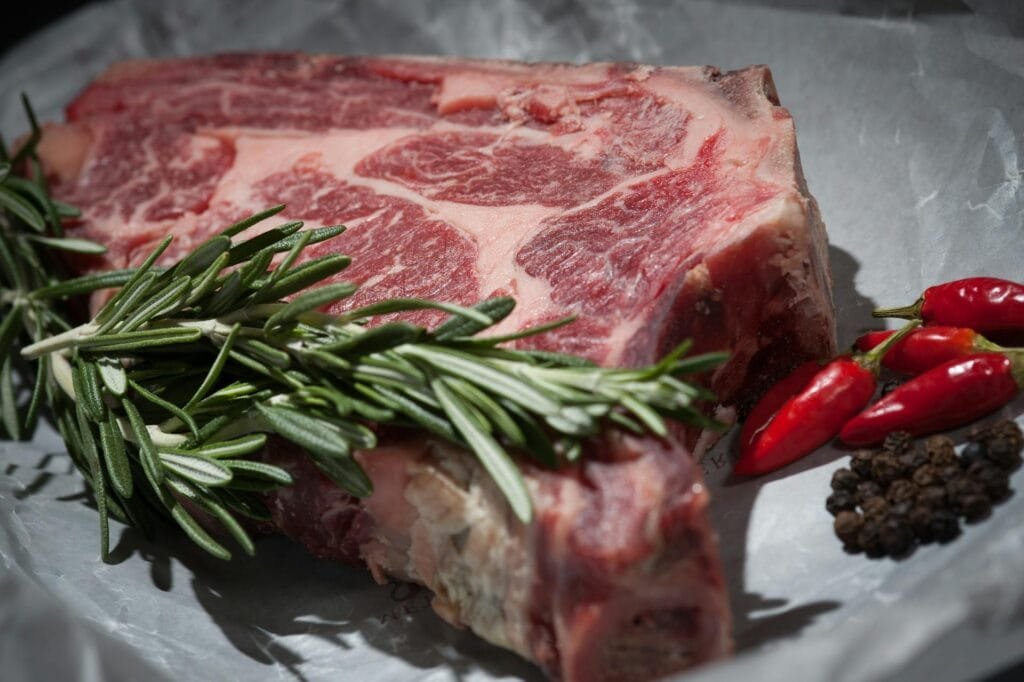
How to cook the perfect steak
Learning how to cook the perfect steak is an important skill for any budding chef. Fortunately all it takes are a good cut of steak, butter and a cast iron pan. Before we get started however we need to look at the different types of steak and their different properties.
Understanding Different Cuts of Steak
When discussing how to cook a steak, one of the most crucial factors to consider is the cut of the meat. Various cuts possess distinct characteristics, flavors, and textures. Notable cuts include ribeye, sirloin, filet mignon, and T-bone, each bringing unique qualities to the table.
Ribeye
The ribeye steak is renowned for its marbling, the little seams of fat through the meat which gives it it’s rich flavor and tenderness. This cut is great for high-heat cooking methods, making it an excellent option for grilling or pan-searing in a cast iron pan. If you are considering whether you should cook a steak on high heat, ribeye is ideal as it maintains juiciness while developing a beautifully charred crust.
Sirloin
Sirloin, on the other hand, is leaner compared to ribeye. It offers a robust flavor profile and works well with both oven and stovetop cooking. The question of whether it is better to cook a steak in the oven or on top of a stove may depend on personal preference and cooking skill. While stovetop cooking can yield a crispy exterior, roasting in the oven may help in achieving even cooking throughout the meat. The stovetop in contrast is an easier technique for beginners since you can really keep an eye on things
Filet Mignon
Filet mignon is celebrated for its tenderness and mild flavor. This cut requires gentle cooking techniques, which can be achieved using moderate stove heat or a controlled oven environment. Cooking with a frying pan ensures that you achieve a beautiful crust while retaining the luxurious mouthfeel of this exceptional cut.
T Bone
The big daddy. T-bone, a cut that includes both a strip steak and a tenderloin. It combines the best of both worlds, offering tenderness and rich flavor. Its thick composition makes it suitable for grilling, where high heat helps develop a seared surface while preserving moisture.
Essential Preparation Techniques
Preparing a steak properly before cooking is crucial for achieving a perfect dish. Typically I throw a generous amount of kosher salt on the steak 30 mins before I’m ready to cook. This draws out some of the moisture from the surface of the steak. After this time I dry the steak with paper towels. I also let the steak rest at room temperature before we start cooking. This drying and warming technique helps us form the crust when we cook the steak.

My next step is to coat each steak in about 1 tablespoon of Olive oil. I then season each steak with a generous amount of black pepper and kosher salt. This will help form the crust.
Cooking Methods for Steak Perfection
There are several popular methods for cooking steak, each with its unique attributes: grilling, pan-searing, and broiling. Understanding how to cook a steak on high heat can greatly impact the outcome.
Grill baby grill
Grilling is a great method that offers a woody, smoky flavor. To grill a steak efficiently, preheat the grill to a high temperature, ideally around 450°F to 500°F. Season the steak with salt and pepper and place it directly on the grill grates. Cook for about 4-6 minutes on one side before flipping, depending on thickness and desired doneness. Don’t move the steak too much because you want to keep those iconic burn lines. For an even cook, ensure that both sides receive an adequate sear. Grilling also allows for easy monitoring of temperature, making it effective for those who prefer a specific doneness level.
Broiling
Broiling, which utilizes high-heat from above, is equally effective. To broil a steak, preheat the broiler, placing the oven rack close to the heating element. Position the steak on a broiler pan, allowing the fat to drain away. Cook each side for about 4-7 minutes. This method works well for achieving caramelized surfaces quickly.
Pan searing
My personal favorite method is pan searing with a cast iron pan. This method involves cooking the steak in a pan over high heat. I prefer to keep the pan dry and apply the oil to the steak. Sear the steak for approximately 3-5 minutes on each side, depending on thickness. Once again don’t move it too much. I also add a knob of butter for each steak and use a spoon to ladle the melted butter over the steak as it cook. I also love to throw in some rosemary or garlic to jazz it up a little. This gives a rich, crusty exterior while maintaining a juicy interior.
Finishing Touches and Serving Suggestions
Once you have cooked your steak to perfection, the next crucial step is to let it rest. Resting the steak allows the juices to redistribute throughout the meat, resulting in a more tender and flavorful experience. After cooking, transfer the steak to a cutting board or a warm plate and cover it loosely with aluminum foil to keep it warm. Ideally, you should let it rest for about five to ten minutes, depending on the thickness of the steak. This ensures that when you cut the steak, it does not lose excessive juices.
When it comes to slicing your steak, the orientation is key. Always slice against the grain to maximize tenderness. Take a moment to note the direction of the muscle fibers and cut perpendicular to them. This shows off the marbling and the texture of the steak
To kick it up a notch, try serving it with carefully curated accompaniments. A classic choice is a a red wine reduction or a creamy peppercorn sauce, which can complement the steak’s natural flavors. I love serving roasted vegetables, garlic mashed potatoes, or a fresh arugula salad provide a great contrast to our big slab of meat. As for wine pairings, red wines, particularly Cabernet Sauvignon or Malbec, are excellent choices that enhance the overall dining experience.
Ultimately it depends on the cut of meat you are cooking which often determines the best way to cook. Beginner chefs may prefer the cast iron pan method because they can keep an eye on whats going on. Whichever technique you choose it is possible to get steakhouse quality steaks in your own kitchen.






